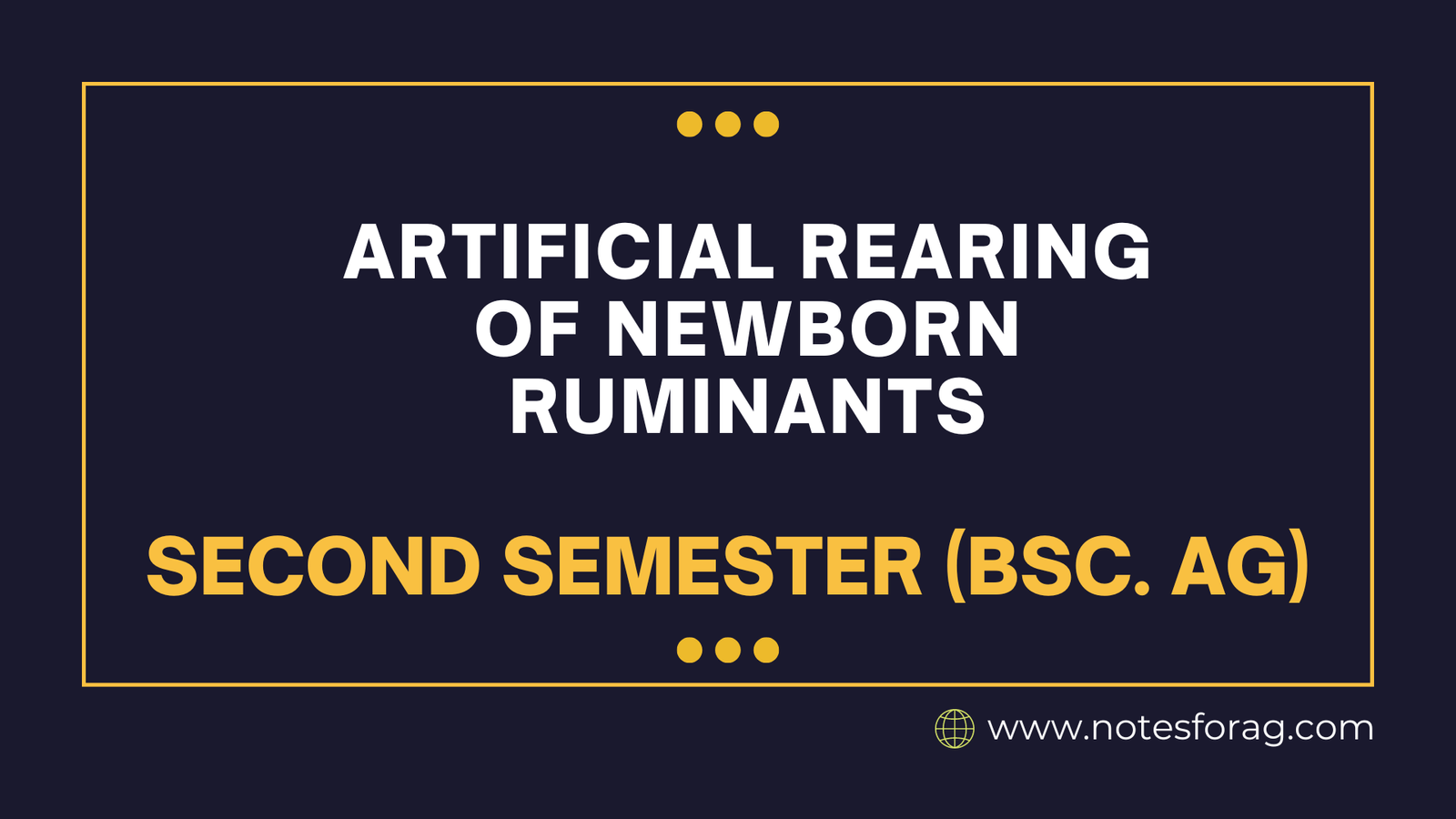Artificial rearing of newborn ruminants involves raising calves, lambs, and kids without their mothers’ care, typically due to health issues, management decisions, or orphaned status. It entails giving vital nutrients via milk substitutes and colostrum, constructing a appropriate home with enough heating and ventilation, and keeping a careful eye on developmental milestones and overall health. In order to promote the best possible physical and behavioral development and protect the welfare of the young animals, this method attempts to closely simulate natural conditions.
Table of Contents
Artificial Rearing

Artificial rearing is the practice of raising young animals without the presence of their mothers, including ruminants like calves, lambs, and young animals. This approach is utilized in situations where natural mothering is neither feasible or accessible, frequently because of health problems, managerial choices, or situations involving abandoned children.
Artificial rearing include providing appropriate housing conditions with warmth and ventilation, monitoring health and growth closely, and feeding the animal with colostrum and milk replacers that are suited to its nutritional demands. By encouraging healthy development and preparing the animals for ultimate integration into the herd or flock, the aim is to emulate natural caring as precisely as possible.
Why Artificial Rearing?
- Orphaned Lambs and Kids: If a mother dies or rejects her offspring, artificial rearing may be the only option for survival.
- Weak Lambs/Kids: In situations where a lamb or kid is too weak to compete for milk from its mother, artificial rearing provides a chance for survival.
- Disease Control: In cases of contagious diseases like mastitis (udder infection) in the mother, separating the offspring can prevent transmission.
- Multiple Births: With some breeds known for producing twins or triplets, artificial rearing can supplement the mother’s milk supply if she cannot adequately nourish all offspring.
Advantages
Artificial rearing of newborn ruminants offers several advantages:
- Improved Survival Rates: When done correctly, artificial rearing can improve the survival rate of weak or orphaned lambs and kids.
- Controlled Nutrition: Milk replacers can be formulated to meet the specific nutritional needs of the growing animal.
- Reduced Disease Transmission: Separation from the mother can minimize the risk of certain diseases.
- Flexibility in Management: Artificial rearing offers flexibility in managing flocks or herds, enabling controlled cycles of reproduction, selective breeding, and genetic enhancement.
- Reduced Stress: Adequate care and housing in a supervised setting can help babies feel less stressed, which will improve their ability to adapt and develop their behavior.
- Economic considerations: Artificial raising may occasionally be less expensive than conventional techniques, particularly when labor expenses are taken into account or resource optimization is possible.
- Education and Training: It gives caregivers the chance to advance their knowledge and abilities in veterinary medicine and animal husbandry, which helps to improve farm management techniques.
- Better Growth Rates: Young ruminants can acquire weight more quickly and gain it at a better rate if their feeding regimens and nutrition are well managed.
Disadvantages
Artificial rearing of newborn ruminants also comes with several disadvantages:
- Labor Intensive: Artificial rearing requires frequent feedings, cleaning of feeding equipment, and close monitoring of the animal’s health.
- Costly: Milk replacer, specialized equipment, and increased labor costs can make artificial rearing expensive.
- Reduced Immunity: Newborn ruminants receive vital antibodies from their mother’s colostrum. Artificial rearing may require supplementation with colostrum replacer or colostrum from another healthy animal.
- Behavioral Issues: Animals reared artificially may miss out on vital social learning and develop behavioral problems later in life.
- Lack of Maternal Bonding: Infants reared in artificial environments are not exposed to the experiences of natural bonding and behavioral learning that come with maternal care, which may have an impact on socialization and future behavior.
- Health Risks: If feeding procedures or cleanliness guidelines are not strictly adhered to, artificial rearing may raise the risk of health problems such diarrhea, respiratory infections, and nutritional deficits even with monitoring.
- Dependency on Technology: Reliance on artificial surroundings and milk substitutes implies a reliance on technology and resources, which might be jeopardized by problems with supply chains or logistics.
- Environmental Impact: It can be difficult to manage waste and uphold environmental sustainability, particularly in intensive rearing systems where nutrient management and manure disposal are essential.
- Ethical Considerations: There are ethical questions regarding the handling and welfare of the animals since some claim that artificial upbringing disturbs normal animal behaviors and welfare.
The practice of artificially rearing newborn ruminants entails growing calves, lambs, and young without the presence of their mothers, usually as a result of health problems, managerial choices, or the status of orphans. For growth and development to be at their best, careful attention to housing, diet, and health monitoring is needed. Even though it offers benefits like restricted diet, health tracking, and management flexibility, it also has drawbacks including poor mother-child bonding, health hazards, intense labor, and behavioral problems. Mitigating dangers and promoting the welfare of ruminants raised artificially requires careful management and adherence to best practices.
Frequently Asked Question(FAQ)
Why is artificial rearing necessary for newborn ruminants?
Artificial rearing becomes necessary when health problems, managerial choices, or the offspring’s orphan status render natural maternal care insufficient or unavailable.
What are the key considerations for housing newborn ruminants artificially?
Housing should reduce stress and illness risks while offering warmth, ventilation, and room for mobility. Maintaining one’s health requires good cleanliness and hygiene.
Related Articles

